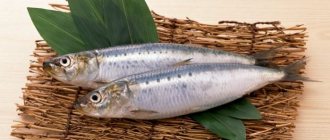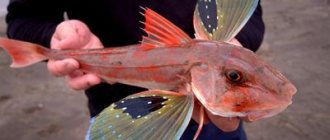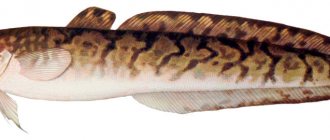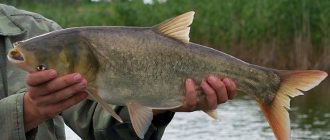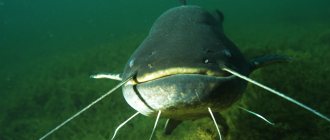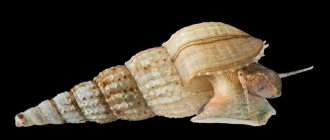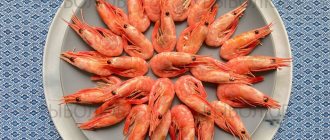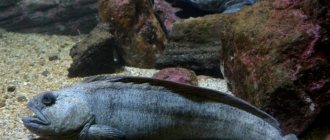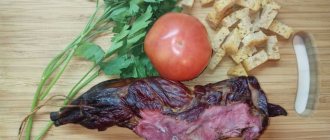Nutritionists are confident that eating seafood is necessary to maintain human health. They are rich in proteins and minerals. The whelk clam is a wonderful representative of the marine world, which often remains in the shadows. However, there is no need to be afraid. This product will pleasantly surprise you with its taste and properties.
Have you tried shellfish?
- Yes 58%, 301 votes
301 votes 58%301 votes - 58% of all votes
- No 42%, 214 votes
214 votes 42%
214 votes - 42% of all votes
Total votes: 515
03.10.2019
- Yes 58%, 301 votes
301 votes 58%301 votes - 58% of all votes
- No 42%, 214 votes
214 votes 42%
214 votes - 42% of all votes
Total votes: 515
03.10.2019
×
You or from your IP have already voted.
Breaded
Seafood in batter is a tender and healthy dish that saturates the body with protein. Preparatory stage - 5 minutes. Cooking time: 15 minutes.
Ingredients:
- trumpeter - 500 g;
- eggs - 2 pcs;
- flour - 3-4 tbsp. l.;
- sunflower oil - 2 tbsp;
- salt - a pinch.
Step by step recipe:
- Prepare a batter from eggs and flour. To do this, you need to beat the ingredients together using a blender. The dough should be liquid, like for pancakes.
- Pepper the shellfish pieces.
- Dip them into the dough.
- Heat a frying pan with sunflower oil.
- Fry each slice for 5 minutes.
The calorie content of shellfish in batter is 289 kcal per 100 grams.
Proteins - 36.7.
Fats - 9.2.
Carbohydrates - 14.7.
Contraindications and possible harm
The beneficial properties of the whelk are combined with the potential harm of the mollusk. It cannot be used:
- if you are allergic to seafood;
- for gout;
- in children under 12 years of age;
- with a tendency to constipation;
- during breastfeeding.
During pregnancy, shellfish is not prohibited for consumption, but you should consult your doctor before introducing it into your diet.
It is impossible to eat trumpet raw without heat treatment - it may contain intestinal parasites
Marinated
Pickled food tastes completely different. It turns out spicy and interesting. A trumpeter in a jar is perfect for a winter feast. It is quick and easy to prepare.
Preparatory stage - 5 minutes.
Cooking time: 45 minutes.
Ingredients:
- trumpeter clam - 400 g;
- onion - 1 piece;
- garlic - 4 cloves;
- carrots - 2 pcs;
- bell pepper - 3 pcs;
- salt;
- sugar;
- tomato paste;
- allspice;
- Bay leaf;
- vinegar - 2 tbsp.
Cooking method:
- Boil the seafood thoroughly.
- Chop the onion into half rings and salt it.
- Pour vinegar over the rings. Leave for 5 minutes.
- Remove meat from heat. Let cool.
- Cut the clam into thin strips.
- Prepare a container for marinating. This could be a jar or a glass.
- Layer all the ingredients: trumpet meat, onion, garlic, chopped carrots and pepper. Repeat the sequence until the jar is full. The last layer should be the clam.
- Boil water for the marinade. Remove from heat.
- Add all the spices and tomato paste indicated in the list of ingredients. Do it to taste.
- Allow the water to cool naturally.
- Add tbsp. vinegar.
- Pour the marinade over the contents of the jar.
- Leave for several hours.
The calorie content of pickled trumpet is 156 kcal per 100 grams.
Proteins - 23.2.
Fats - 1.4.
Carbohydrates - 12.7.
Kinds
Trumpeter is a mollusk distributed throughout almost the entire world's oceans, from littoral to bathypelagic zones. Large species are found in both northern and southern seas, in temperate and cold waters. Most prefer hard bottoms, but some inhabit sandy substrates.
A familiar species of marine fauna of the North Atlantic, which is found on the shores of Great Britain, Ireland, France, Norway, Iceland and other countries of northwestern Europe, and some Arctic islands, is the common buccinum or wavy horn.
This whelk gastropod prefers cold waters with a salt content of 2-3%, and cannot survive at temperatures above 29°C; it does not adapt well to life in the littoral zone due to intolerance to low salinity. It lives on different soils, but most often on the muddy and sandy bottom of the ocean, at depths from 5 to 200 meters.
Adults prefer deeper areas, while juveniles are found near the shore. The color of the shell is usually difficult to determine because the mollusk is either camouflaged under algae or covered in barnacles. Neptunea is found in the Arctic seas; in the southern temperate seas - large species of the genus Penion, known as the siphon whelk (because it has a very long siphon).
A species endemic to the Sea of Japan that can be found in the coastal waters of South Korea and eastern Japan is Kelletia Lischke. In the southern part of the Sea of Okhotsk and in the Sea of Japan, Buccinum vercrusen (or Sea of Okhotsk buccinum) is widespread.
Trumpet salad
Trumpeter is a healthy and tasty seafood product. It is rich in proteins and vitamins necessary for the human body. Adding such a product to salads will supplement them with nutrients and also make them more satisfying.
Preparatory stage - 5 minutes.
Cooking time: 15 minutes.
Ingredients:
- clam - 1.5 kg;
- canned peas - a jar;
- boiled eggs - 2 pcs;
- pickled cucumbers (you can take salted ones) - 4 pcs;
- boiled rice - 100 g;
- onion - 1 piece;
- vinegar;
- mayonnaise - 3 tbsp.
How to prepare the salad:
- Boil the trumpet meat in salted water for a couple of minutes.
- Grind the eggs.
- Soak the onion in vinegar. You can also pour boiling water over it.
- Cut the pickled cucumbers into cubes.
- Mix all ingredients in a salad bowl.
- Season with three tablespoons of low-fat mayonnaise.
- Sprinkle salt and pepper.
The calorie content of trumpet salad is 215 kcal per 100 grams.
Proteins - 32.3
Fats - 2.6.
Carbohydrates - 15.6.
Summer salad with trumpet
Preparatory stage - 5 minutes.
Cooking time: 10 minutes.
This option is suitable as an addition to main courses. The salad turns out light and juicy.
Ingredients:
- shellfish - 0.2 kg;
- lettuce - 1 kg;
- boiled eggs - 2 pcs;
- fresh cucumber - 4 pcs;
- tomatoes - 2 pcs;
- low-fat mayonnaise or yogurt.
Preparation:
- Tear the lettuce leaves with your hands.
- Boil the shellfish over low heat.
- Chop tomatoes and cucumbers.
- Mix all ingredients in a bowl.
- Add spices.
- Season the salad with light mayonnaise.
The calorie content of summer salad with trumpet is 165 kcal per 100 grams.
Proteins - 16.8.
Fats - 8.1.
Carbohydrates - 6.6.
Nutrition
The Trumpeter is carnivorous. Some species of the family are predators, eating other mollusks, others are carrion eaters. The diet of the common buccinum is described in most detail. It feeds on polychaete worms, bivalves, sometimes dead or killed starfish, and sea urchins.
When hunting, the whelk uses chemoreceptors in its osphradium (an organ inside the pallial cavity) and a strong leg to propel itself along the bottom at more than 10 centimeters per minute. Possessing an excellent sense of smell and sensing the flow of water flowing from the feeding tubes of the mollusk, it is able to distinguish between potential prey and predator.
As soon as prey is discovered, the mollusk tries to deceive the victim and burrows into the bottom. He waits until the bivalve opens the halves of the shell. The problem is that mussels cannot breathe with their shell halves closed and must sometimes open to avoid suffocation.
The trumpeter pushes the siphon between the halves and thus prevents the sink from closing. The siphon is followed by a proboscis with a radula. Using long sharp teeth, it tears pieces of meat from the soft body of the mussel, eating it in a short time.
The clam also uses the outer lip of the shell to cleave and open the shell by holding it with its foot so that the ventral edges of the bivalve valves are under the outer lip of the whelk shell. The chipping continues until a hole is created, allowing the whelk to squeeze its shell between the valves of the prey.
Another method of obtaining food, if the prey is not a bivalve, is to use a chemical secreted by the gland that softens calcium carbonate. The radula can be used effectively to drill a hole into a victim's shell.
With mushrooms and beef
The option of preparing shellfish with red meat may seem extravagant to some housewives. However, such a treat will become the king of the table, impressing all the guests. This dish requires clams in shells. Clean meat will not work.
Time to prepare ingredients: 60 minutes.
Cooking time: 40 minutes.
Note! It is very important to thoroughly clean sand from mollusk shells. It is recommended to use a toothbrush for this. The presence of dirt in the shell will negatively affect the properties of the dish.
Ingredients:
- shells - 40 pcs;
- Chinese mushrooms - 10 pcs;
- beef - 350 gr;
- green onion - a bunch;
- garlic - 4 cloves;
- egg - 1 pc.
- soy sauce - 2 tbsp;
- salt;
- black and red pepper.
Cooking method:
- Defrost the shells, rinse and clean them thoroughly.
- Pour salt water over the clams. Leave for an hour.
- Soak Chinese mushrooms in warm water for 40 minutes.
- Wipe the mushrooms with a dry towel to remove moisture. Cut off the legs.
- Cut the caps into thin strips.
- Let the trumpeter cook for 6 minutes. Wait until it boils.
- Remove the shellfish meat from the boiled shells.
- Grind the beef in a meat grinder or blender.
- Mix the minced meat with trumpet, mushrooms, onions and garlic. Also pour in the raw egg. Mix the mixture well.
- Add soy sauce and spices.
- Stuff the shells with a small amount of filling.
- Place them in a steamer for 10 minutes.
Note! If you don’t have a double boiler, you can use a colander that is placed over a pan of boiling water. Example in the photo.
The calorie content of trumpeter with beef and mushrooms is 304 kcal per 100 grams.
Proteins - 35.9.
Fats - 10.2.
Carbohydrates - 15.6.
What it looks like and where it is found
The whelk is a predatory gastropod from the Trumpeter family of the same name. It has an elongated and widened shell with or without axial thickenings and spiral carinae. The color of the mollusk in the outer part is light or dark brown, with a horny cap and a smooth inner lip, and has no teeth.
The length of the whelk shell can reach 25 cm
The whelk lives in the temperate seas of the Northern Hemisphere and Southern Hemisphere, as well as in tropical waters. Lives far from the shore at the bottom. It is fished in England, Scotland, the Far East and Sakhalin in Russia, and is popular in Japan. Catching shellfish begins in October and ends by February.
The whelk feeds on small fish, snails and worms. The saliva of a predator has paralyzing properties, so it absorbs its prey while still alive. It easily opens the shells of bivalve mollusks, especially actively hunts mussels and can destroy entire colonies of them in a short time. Along with this, it is a scavenger.
The marine mollusk reproduces in the summer. Females deposit special capsules on underwater rocks and other objects. Although each sac may contain several hundred eggs, only about five whelks ultimately survive. At first, they feed on the remains of unhatched relatives, and then emerge from the capsule to the outside with a small shell already formed.
Attention! The whelk is a fairly ancient mollusk. It first appeared on Earth at the beginning of the Paleogene, and the population peaked during the Quaternary period.
Stewed in cream
The most common method of preparing seafood is boiling. However, he is not the only one. The whelk clam stewed in cream turns out to be especially tender and juicy, and only 3 ingredients are required for preparation.
Preparatory stage - 8 hours.
Cooking time: 25 minutes.
Ingredients:
- clam - 400 gr;
- cream 10% - 250 ml;
- large onion - 1 pc.
- spices - to taste.
Step by step recipe:
- Pour a glass of low-fat cream over the washed shellfish meat.
- Place in the refrigerator overnight.
- Chop a large onion.
- Fry it in a frying pan.
- Catch the whelk from the cream and cut into small pieces.
- Add the clam to the onion in the pan.
- Pour the cream in which the trumpet was marinated into the simmering ingredients.
- Add spices.
Note! It is not worth keeping the dish on the fire for a long time. The clam may become rubbery. The photo shows an example of the color of properly boiled trumpet.
The calorie content of trumpeter in cream is 170 kcal per 100 grams.
Proteins - 25.
Fats - 3.2.
Carbohydrates - 10.6.
Chemical composition
The benefits and harms of trumpeter are determined by its chemical composition. Shellfish meat contains:
- vitamins B1, B2, B5 and B9;
- choline;
- ascorbic acid;
- carotene;
- sodium, iron and calcium;
- vitamin B12;
- potassium and phosphorus;
- selenium and zinc;
- tocopherol;
- vitamins K and PP;
- manganese, copper and magnesium.
The sea mollusk has a soft fillet and a pleasant taste and aroma; it is most associated with rapana. Its structure is more delicate than that of octopus and squid.
Trumpet calorie content
The mollusk has a very low energy value and is well suited for dietary nutrition. In 100 g of its meat there are only 24 calories. About 17 g are proteins, fats and carbohydrates account for 0.4 and 2.8 g, respectively.
We recommend reading: Buffalo meat: benefits, properties, how it differs from beef
Fricassee
Preparatory stage - 5 minutes.
Cooking time: 30 minutes.
Ingredients:
- trumpeter clam meat - 1.5 kg;
- tomatoes - 1.2 kg;
- vegetable oil - 2 tbsp;
- garlic - 4 cloves.
Step-by-step cooking recipe:
- Boil a liter of water over medium heat.
- Add clams to pan and cook for 2 minutes.
- Scald the tomatoes with boiling water, peel them and remove the seeds.
- Cut vegetables into cubes.
- Fry the tomatoes in vegetable oil along with garlic. Bring to a thick porridge.
- Add sliced trumpet to the pan.
- Salt and pepper to taste.
- Leave to simmer on low heat for 3 minutes.
- Serve the dish with boiled rice, fresh vegetables or salads.
The calorie content of fricassee is 180 kcal per 100 grams.
Proteins - 28.6.
Fats - 1.2.
Carbohydrates - 14.4.
How is a trumpet player useful?
Thanks to its rich chemical composition, whelk has numerous beneficial properties. When consumed correctly, shellfish:
- saturates the body with easily digestible protein;
- reduces cholesterol levels in the blood and improves the condition of blood vessels;
- has a beneficial effect on cell membranes and promotes rejuvenation of the body;
- improves blood clotting;
- accelerates tissue regeneration;
- fights inflammatory processes;
- prevents the destruction of muscle fibers after intense physical activity;
- has a beneficial effect on the functioning of the thyroid gland;
- accelerates metabolic processes and normalizes digestion;
- has a strengthening effect on bones and joints.
Low-calorie whelk can be used in the diet. The shellfish does not provoke weight gain, but it cleanses the intestines of toxins and helps you lose weight while maintaining healthy muscle mass.
The whelk clam stimulates brain function and improves memory
To avoid spoiling your purchase
Most often, all this exotic stuff comes to us in a frozen state. So before you cook seafood, you need to defrost it properly. Each of them has its own limitations. In particular, whelk (mollusk) should never be defrosted in water. It should thaw in the refrigerator. If you do not have enough time, it is acceptable to defrost it at room temperature, but it is still advisable to avoid this. And for cooking, knowledgeable people advise pouring the water extremely cold - even adding ice to it. They say that this way the meat turns out much softer.
And, like any sea creature, whelk cannot be digested. To do this, some chefs recommend not boiling it at all, but removing it just before the water begins to boil. However, other sources indicate just cooking, albeit for a very short time. You will have to choose for yourself which advice to follow.
The character and lifestyle of a trumpeter
Trumpeter is a marine mollusk . The temperament of trumpeters, like all gastropods, is similar to phlegmatic. They live on the bottom and move slowly. The foot walks along the ground, protruding the entrance cap back, and the head is constantly in motion, turning in the direction from which the current carries the smells of possible food.
In a calm state, the speed of movement is 10-15 cm/min, but during the period of active search for food it can increase to 25 cm/min. Mollusks have long lost paired gills, so trumpeters breathe with one gill cavity - oxygen enters the body from filtered water.
The water is filtered by a special organ - a siphon, which at the same time serves as a tactile organ that helps the mollusk look for a place with the optimal temperature and get food, including by the smell of decomposition.
The process of feeding and movement of the trumpet clam can be clearly seen in the photo. Its siphon also helps this sea snail avoid encounters with potential enemies - starfish, as they secrete a specific chemical.
But having dodged one predator, the whelk can become a victim of another: medium or large fish, crab, walrus and other sea animals. Even a dense shell will not be an obstacle for the walrus - it simply gnaws it and grinds it along with the body of the mollusk.
Reproduction and lifespan
Trumpeters are dioecious mollusks. The mollusk reaches sexual maturity at 5-7 years. The mating period depends on the region in which they live. In cold areas, mating occurs in the spring when water temperatures rise.
In warm areas, such as the European Gulf Stream, whelks mate in the fall when water temperatures drop. The female attracts the male with pheromones, distributing them in the water at a suitable temperature. Internal fertilization allows the marine organism to produce capsules to protect the eggs.
After 2-3 weeks, females lay eggs in protective capsules attached to stones or shells. Each capsule contains from 20 to 100 eggs, in some species they can be grouped and in large masses, up to 1000-2000 eggs.
The egg capsule allows the embryos to develop while providing protection. However, only one percent of the young survive as most eggs are used as a food source by the growing embryos.
Inside the egg, the embryo goes through several stages. The whelk does not have a free-swimming larval stage. Fully developed tiny sea snails emerge from the capsules after 5-8 months. Young individuals can be from different fathers, since trumpeters mate several times and the female retains sperm until external conditions become favorable.
Gastropods are distinguished by an anatomical process known as torsion, in which the visceral mass (internal sac) of the sea snail rotates 180° relative to the cephalopodium (leg and head) during development. Torsion occurs in two stages:
- the first stage is muscular;
- the second is mutagenic.
The effects of torsion are, first of all, physiological - the body develops asymmetrical growth, internal organs are crossed, some organs of one (usually the left) side of the body decrease or disappear.
This rotation brings the mantle cavity and anus literally above the head; products of the digestive, excretory and reproductive systems are released behind the head of the mollusk. Torsion allows you to protect the body, since the head is collected in a shell in front of the leg.
The life expectancy of a marine mollusk, not counting the human factor, is from 10 to 15 years. The trumpeter grows by using the mantle to produce calcium carbonate to expand the shell around a central axis or columella, creating whorls as it grows. The last whorl, usually the largest, is the body whorl, which ends by providing an opening through which the sea snail can exit.

